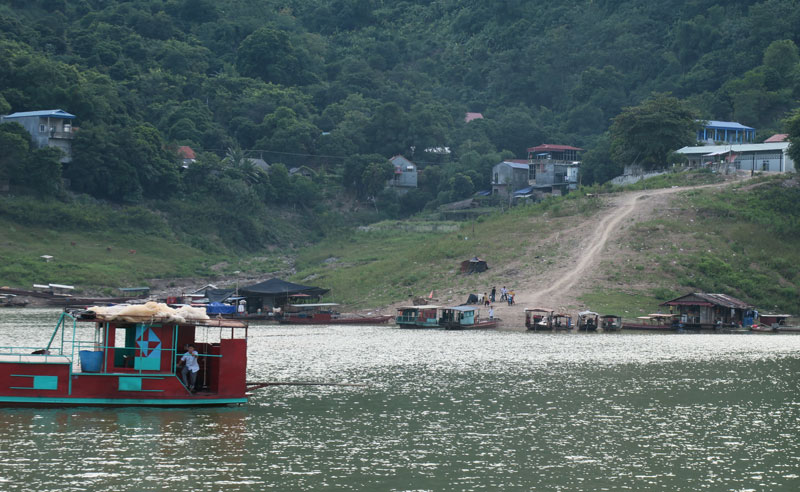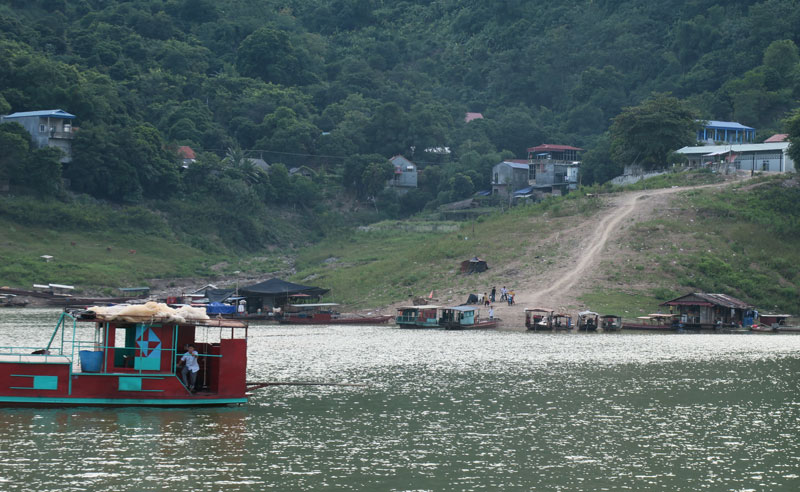
(HBO) - Hoa Binh is known as a place having abundant tourism resources with many beautiful landscapes and caves recognized as the national beauty spots. This is also the place where most important archaeological relics of the famous "Hoa Binh Culture” have been discovered.
Waking the potential up
 Van Yen ferry station, one of the boat stops selected when carrying tourists on Da River of Hoa Binh - Son La route.
Van Yen ferry station, one of the boat stops selected when carrying tourists on Da River of Hoa Binh - Son La route.
There are more than 70 caves containing the archaeological relics of the "Hoa Binh Culture” in the province. More than 40 relics at the national level and 27 relics at the provincial level have been renovated and embellished to develop tourism. In particular, Hoa Binh lake with the beautiful natural landscape, the water surface area of 8,000 ha and the capacity of 9.5 billion square meters of water was approved by the Prime Minister as the Master Plan for developing the national tourist areas in Hoa Binh lake up to 2030 in August 2016.
Strengthening the investment and the development, now there are a number of cultural, ecological, spiritual, sports and community tourist zones, routes and destinations which are in the operation to serve the tourists. They include Hoa Binh Lake tourist area, Phuong Hoang golf course (Luong Son), Mai Chau Ecolodge eco-resort (Mai Chau), Kim Boi Serena Resort (Kim Boi), the museum of Muong cultural space, the museum of cultural heritage of Muong ethnic people (Hoa Binh city), Tien pagoda (Lac Thuy), Thac Bo temple (Da Bac) and the community tourism sites in Lac and Pom Coong, Van and Hang Kia villages (Mai Chau); Luy Ai village (Tan Lac) and so on.
Strengthening the link for development
Hoa Binh is a mountainous province, which is adjacent to Hanoi Capital and it is also the gateway of the Northwestern region with a relatively developed transport network of road and waterway connecting with other provinces in the region, creating the great opportunity for cooperating to develop economy, especially in the field of tourism. In the process of turning tourism into an important economic sector of the province, Hoa Binh signed an agreement to participate in the cooperation program for the tourism development of 8 Northwestern provinces in June 2010. They include Hoa Binh, Son La, Dien Bien, Lai Chau, Lao Cai, Yen Bai, Ha Giang and Phu Tho provinces.
Mr. Luu Huy Linh, the Deputy Director of the Department of Culture, Sports and Tourism says that in recent years, the Department has strengthened the information exchange, sharing difficulties and cooperating to build tourism products that have the unique characteristics of the locality and the general strength of the whole Northwest region. They have been focusing on the investment in tourism infrastructures such as transportation, accommodation facilities, places of interest and entertainment, etc., especially the inter-provincial transport infrastructure and the roads connecting tourist sites and areas within the province in each locality.
The coordination of tourism promotion and organizing events in each province have well done. They have been focusing on developing tourism products with a brand name and high quality. They have also been focusing on the research to build tourist routes, destinations and areas in each locality, creating a highlight to improve the effectiveness of the linkage between the localities. In this route, the Department advised the Tourism Steering Committee of the province to develop the cooperation programs with other tourist centers such as Hanoi, Hai Phong, Quang Nam, Ha Tinh, Son La and Dien Bien, Lai Chau to share experiences and connect tours and travel routes in 2018. In addition, they have been expanding the cooperation of tourism development with other countries such as Hua Phan province (Laos), Russia, Tuv province (Mongolia) ... for the tourist market in Hoa Binh in particular and in the Northwest region in general.
Since the beginning of the year, the province has continued to coordinate with Son La, Dien Bien and Lai Chau provinces to build and put into operation the inter-lake waterway tourism route on Da River. Two major cities, Hanoi and Ho Chi Minh City have been participating in organizing the tourism promotion activities. They have coordinated to build tourism map of the eight expanded Northwest provinces ...
They have synchronous implemented the measures to arouse the potential, strengthening links for mutual development. Tourism in Hoa Binh has shown good signs. In the first 9 months of this year, it has estimated to welcome 2.5 million turns of tourists, of which, the international visitors are 290,000 and the domestic visitors are 2.21 million. The total revenue from tourism is estimated at 1,650 billion VND, reaching 82.5% of the year’s plan. It is expected that the number of tourists will increase at the end of the year, when the Week of the Provincial Culture and Tourism in 2019.
Boasting diverse terrain, a mild climate, and rich natural resources, Cao Phong district is increasingly asserting its place on Vietnam’s tourism map, attracting both domestic and foreign visitors. The district is renowned for its stunning landscapes, majestic mountains, a crystal-clear hydropower lake, and the unique cultural identity of local ethnic groups.
With its pristine landscapes, unique cultural heritage of Muong ethnic minority, and an expanding range of visitor experiences, Tan Lac district of Hoa Binh has fast become a captivating destination for both domestic and international tourists.
Until now, Sung village in Cao Son commune, Da Bac district remains the only Dao ethnic community in Hoa Binh province to develop a community-based tourism model. Beyond its untouched natural landscapes, cultural identity serves as the cornerstone attraction for visitors.
Alongside the diverse cultural identities of the Kinh, Muong, Tay, Thai, Dao, and Mong ethnic people, Hoa Binh province is also renowned as the "capital" of the northwestern Vietnamese cuisine, offering unique and distinctive dishes. At festivals, during Lunar New Year (Tet), or on significant family or community occasions, special dishes are prepared, leaving a lasting impression on visitors.
A Phong Linh (Yellow Tabebuia) flower garden in Thang village, Thach Yen commune, Cao Phong district is currently in full bloom, drawing a large number of visitors.
Community-based tourism has been thriving in Pa Co commune, Mai Chau district thanks to advantages in natural landscape and cultural identity.



 Van Yen ferry station, one of the boat stops selected when carrying tourists on Da River of Hoa Binh - Son La route.
Van Yen ferry station, one of the boat stops selected when carrying tourists on Da River of Hoa Binh - Son La route.